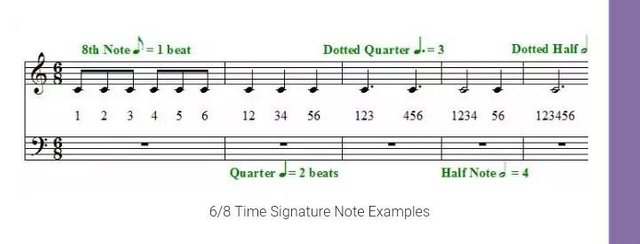MUSIC TIME SIGNATURE
Hello Steemians,
Goodday, I stumble on this while making research for how to understand 6/8 time Signature and I decided to share might be very helpful.
When you’re used to playing music in the standard 4/4 time Signature like me (ashame), switching to 6/8 can be confusing. Most modern songs stick with the common time 4-beat measure, but some older songs (gospel hymnals and classical music in particular) use it all – anything from 6/8, 9/8 and 12/8 to 3/4, 4/4 and 6/4.
To understand any time signature used in music, you first have to understand what the numbers mean. The top number is pretty easy. It is simply the number of beats per measure. If the top number is 4, then there will be 4 beats for each measure. If it’s 6, there will be 6 beats, and so on.
The bottom number of time signature is the unit of measurement. This is a little more tricky to understand, but it basically means that the bottom number controls the top number by telling how many beats each note will get.
In other words, the top number of a song’s time signature tells how many beats per measure, and the bottom number tells how many beats per note.
For example, in 4/4 time, a quarter note gets 1 count. This is the count most people know. And the reason it gets the full count or beat is because the bottom number of the time signature, which is 4, told the top number to get the whole count for each note.
But what happens to the notes in 6/8 time signature?
Just as notes are cut in half for 2/2 time (see below), each note will double in 6/8. An eighth note in 6/8 will receive the quarter note’s usual 1 count, while a quarter note will now receive 2 counts. Click the following image to see a larger view of a few 6/8 note examples.

As you can see from this image, a dotted quarter note, a half note, and a dotted half are also doubled in the 6/8 time signature. When played, 6/8 has a similar sound and feel as 3/4 and other compound time signatures.
The best way to learn about time signatures in music is from practice. As you study songs with a 6/8 time signature, it will begin to make more sense.
To get started, see the song example below of "There Shall Be Showers of Blessing" written in 6/8. Notice how the first measure includes six 8th notes, yet each are receiving a full quarter note beat of one.
Count along with the song to the end, and it will become easier and easier to understand.
In 2/2 time (also called “cut time”), all notes are cut in half. A quarter note in 2/2 receives only an eighth of a count – because the bottom number of the time signature is now 2, which is obviously “half” of 4.
Normally, 4 quarter notes per measure would equal 4 beats in 4/4, but in 2/2 time, 4 quarter notes equals two beats, which is the equivalent of four 8th notes in 4/4. This is due to the time signature’s bottom number of 2 cutting the timing in half.
Content SOURCE
Thanks for reading
You can also leave a comment on how I can improve my time Signature, am open to ideas
I'd like to leave a comment but I got no talent in music, hence, unable to comprehend this article. I salute you tho! From Team Steemit in FB.
Thanks for stopping
Following you right away
This post has received a 5.82 % upvote from @boomerang thanks to: @mittymartz
@boomerang distributes 100% of the SBD and up to 80% of the Curation Rewards to STEEM POWER Delegators. If you want to bid for votes or want to delegate SP please read the @boomerang whitepaper.
This post has received a 0.26 % upvote from @booster thanks to: @mittymartz.
You got a 0.67% upvote from @upme requested by: @mittymartz.
Send at least 1.5 SBD to @upme with a post link in the memo field to receive upvote next round.
To support our activity, please vote for my master @suggeelson, as a STEEM Witness